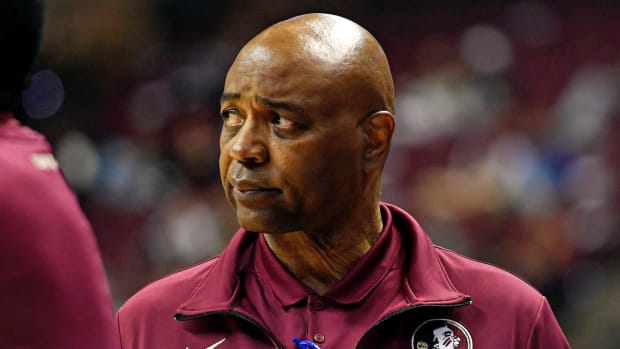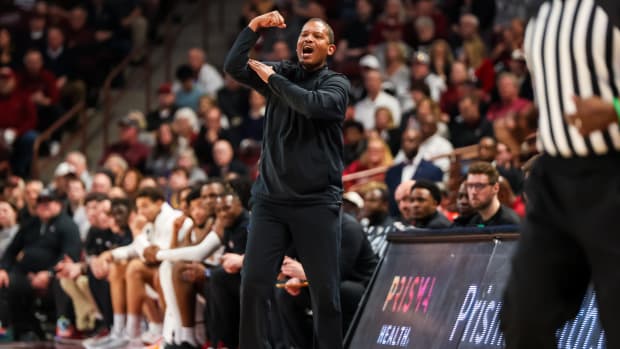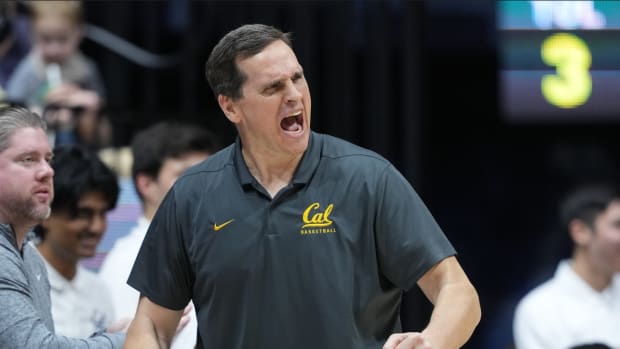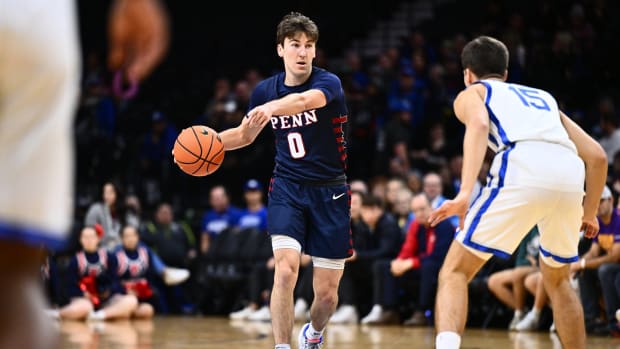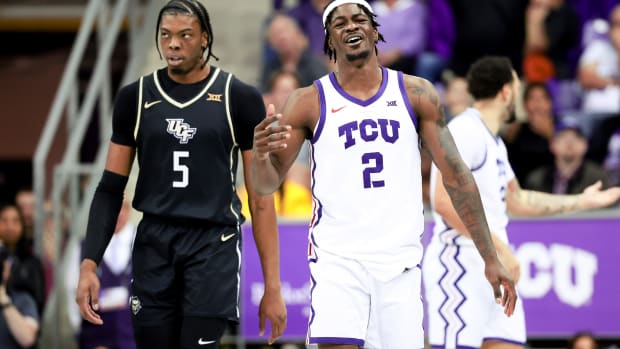Big 12 Offseason Report: Power Rankings and Burning Questions for 2020-21
We didn’t get to see the conclusion to the 2019–20 college basketball season, a year in which two Big 12 teams had a significant chance at reaching the Final Four. The number could expand to three in 2020–21. Baylor is the likely conference favorite after finishing 26–4 last season, while Kansas remains a national championship contender despite a pair of key losses. Texas Tech will have to battle some notable departures, but there’s no lack of talent on the roster. Multiple Big 12 teams should advance to the tournament’s second weekend.
As for the rest of the Big 12, there’s significantly more uncertainty. Texas, West Virginia and Oklahoma are looking to return as Sweet 16 contenders, while the bottom of the conference could still present some tournament teams. The Big 12 isn’t exactly loaded, but it’s certainly competitive. A fun year awaits after a prematurely canceled 2019-20.
MORE: ACC Summer Power Rankings, Burning Questions
Summer Power Rankings
1. Baylor: Baylor was 26–4 before the 2019–20 season was canceled amid the COVID-19 crisis, and the Bears had their eyes firmly on the program's first Final Four since 1950. Scott Drew’s squad has a similar outlook for 2020–21. Baylor returns each of its top three scorers from last season, led by Big 12 Player of the Year candidate Jared Butler (if he withdraws from the NBA draft). One challenge for Drew: replacing Freddie Gillespie, who led the team with 2.2 blocks per game last season. Perhaps slowing teams in the interior will be a challenge for the Bears. Otherwise, this is a rock-solid roster that should be considered the Big 12 favorite.
2. Kansas: A slate of NCAA allegations could end Bill Self’s tenure in Lawrence in ugly fashion, though that conversation is currently more a hypothetical than anything. Let’s keep the focus on the Jayhawks’ chances for the 2021 Big 12 title, which could prove to be a bit of an uphill climb.
Kansas thrived in the paint in 2019–20, relying heavily on center and Big 12 Player of the Year Udoka Azubuike. The 270-pound big man bullied frontcourts across the Big 12, averaging 14.9 points and 11.9 rebounds per game as Kansas won its last 16 contests before the season’s cancellation. And Azubuike isn’t the only notable name exiting the program. Guard Devon Dotson will likely stay in the NBA draft after leading the team in scoring, and senior guard Isaiah Moss is also leaving the program. Self will need his newcomers to step-up in a major way.
Self should still have solid talent at his disposal. Seven members of the 2019–20 team should return this season—including veteran guards Ochai Agbaji and Marcus Garrett—and five-star guard Bryce Thompson could be an impact piece early on. The Jayhawks should compete for the Big 12 title. But don’t consider them the conference favorite.
3. Texas Tech: The Red Raiders will have to mitigate a slew of losses from their 2019-20 team, including leading scorers Jahmi’us Ramsey and Davide Moretti. But if any coach can handle the departures, it’s Chris Beard. Texas Tech’s head coach is 94–44 in three seasons in Lubbock, including a national title game appearance in 2019. Beard could work more magic with Texas Tech in 2020–21.
Beard has some quality talent incoming as he enters his fourth year with the Red Raiders. Micah Peavy and Nimari Burnett should make a modest imprint in their freshman seasons, joining returning guard Kyler Edwards. If Mac McClung is granted eligibility, this could be the Big 12 favorite. If the Georgetown transfer has to sit, a tournament appearance is still quite likely.
4. Texas: Back-to-back seasons missing the NCAA tournament has called Shaka Smart’s job security into question, but the Longhorns should have enough talent to keep Smart off the hot seat in 2020–21. Austin native and SI All-American Greg Brown, a 6’ 9” wing, enters the program as a five-star recruit, and one who could become the Longhorns’ lead offensive option by midseason. This isn’t similar to the case of Mo Bamba or Jarrett Allen, who needed to be force-fed lobs and entry passes from Texas’s guards. Brown is a true end-to-end force in transition, and he has a smoother jumper than one would assume. He could rise to the top five in the 2021 draft.
Brown may live up to the hype, but the Longhorns will likely still fall short of competing for the Big 12 title. Senior Matt Coleman has proven to be an inconsistent point guard in his time in Austin, and there is limited upside across the roster. Adding Brown to a veteran roster should land Texas a middling seed in the NCAA tournament, which would be considered a success given Smart’s recent failures. But don’t expect a run past the opening weekend.
5. West Virginia: Last season served as a bit of a transition year for West Virginia, but Bob Huggins and Co. should be primed for a bounce-back season in 2020-21. The Mountaineers could have one of the best big-man duos in the nation, returning All-Big 12 selection Oscar Tshiebwe and fellow forward Derek Culver. Guard Jordan McCabe could swing West Virginia’s season. The junior played limited minutes last season as he struggled from beyond the arc, but he still fits the mold of a reliable starting point guard, especially in Huggins’s offense. A strong season from McCabe could make the Mountaineers legitimate contenders for the Sweet 16.
6. Oklahoma: Lon Kruger has made Oklahoma a model of consistency in the Big 12, reaching the tournament in six of the last seven seasons before the 2020 edition was canceled. And the Sooners should be in good shape to return to the tournament in 2021. Forward Brady Manek may earn his second straight All-Big 12 appearance in his senior year, and he should continue his growth beyond the arc as one of college basketball’s best frontcourt shooters. Manek will lose frontcourt mate (and 2019-20 leading scorer) Kristian Doolittle, though 6’ 5” guard Austin Reaves should pick up the scoring slack in his senior season. The Sooners sport a deep, veteran roster, one that should have little trouble reaching the NCAA tournament.
7. Iowa State: Tyrese Haliburton’s departure will leave a serious void atop Iowa State’s roster, though at least the Cyclones had a chance to acclimate without the likely future lottery pick as he missed 10 games due to injury in 2019-20. Penn State transfer Rasir Bolton should be the team’s leading scorer, while fifth-year senior Solomon Young should find an increased role. Keep an eye on freshman center Xavier Foster. The top recruit in the state of Iowa is a legitimate seven-footer, and he could create an imposing frontcourt duo alongside Young. Iowa State still lacks a headline talent, and it could be more suited for the tournament in 2021–22. But there should be some progress in the sixth year of the Steve Prohm era.
8. Oklahoma State: There is a fairly high ceiling for Oklahoma State as Cade Cunningham stays with the program despite a postseason ban, but there’s significant volatility for the Cowboys entering 2020–21. Oklahoma State went just 18–14 (7–11 in Big 12 play) in 2019–20, and both of its leading scorers have graduated. Aside from Cunningham, junior Isaac Likekele should see an expanded role in the offense, adding scoring punch alongside the heralded prospect. But if Cunningham is a one-man band, it could be a long year in Stillwater.
9. TCU: TCU limped to a 16–16, 7–11 Big 12 finish in 2019–20, on pace to miss the NCAA tournament for the third time in four seasons under Jamie Dixon. Next year could provide another March outside the tournament, though there should be some semblance of optimism in Fort Worth. Juniors RJ Nembhard and Kevin Samuel should help carry the scoring load after Desmond Bane’s exit, and USC transfer Charles O’Bannon Jr. joins the program as a former five-star recruit. This is a team with some upside, though TCU still stands as a longshot to finish in the top half of the conference.
10. Kansas State: The Wildcats finished last in the Big 12 in 2019–20, and 2020–21 could mark another season in the conference cellar. Leading scorer Xavier Sneed has left the program, as has veteran Cartier Diarra and three-year starting center Makol Mawien. UTEP grad transfer Kaosi Ezeagu could make a modicum of an impact, as could four-star point guard Nijel Pack. But there remains a dearth of talent across the roster, making a tournament appearance a relative pipe dream.
Big 12 Burning Questions
1. Will Baylor break through to the Final Four?
Perhaps you can ding Scott Drew for the occasional tournament let down with a talented team, but his consistency at Baylor since 2003 is truly impressive. The Bears had a 15-year tournament drought before Drew arrived in Waco, and the program hadn’t won a tournament game since 1950. Drew has completely transformed the program, now holding two Elite Eight appearances under his belt. But the Final Four continues to elude the 49-year-old. Next season's tournament may be his best chance.
Baylor enters 2020–21 with a roster that could nearly return in full. Guard Jared Butler could contend for Big 12 Player of the Year honors, and he’ll be joined in the backcourt by dynamic scorer MaCio Teague if both withdraw from the NBA draft. If Baylor finds a way to protect the rim, it could finally advance to the Final Four.
2. What is Bill Self’s future?
Bill Self is no stranger to balancing coaching responsibilities with off-court concerns, but the 2020-21 season could provide the greatest test of his tenure with the Jayhawks. Kansas has been issued a notice of allegations regarding multiple Level I infractions and will go to independent review, which could lead to a postseason ban, recruiting sanctions and potentially Self’s job. We won’t jump the gun and make any grand conclusions for now. Perhaps Self will weather the storm and carry the Jayhawks to yet another Big 12 title. But his future in Lawrence is in no-way guaranteed. The clock may be ticking on the second-winningest coach in program history.
3. Can Greg Brown bring Texas back to prominence?
Shaka Smart’s shortcomings have been evident in Austin in recent seasons, but there’s no doubt the former VCU head coach can recruit. Smart coached Allen in 2016–17 and Bamba the next season, consistently showing the ability to bring in top-50 recruits. But the impressive recruiting hasn’t led to much on-court success. The Longhorns have yet to win a tournament game in five years under Smart, and they’ve missed the Big Dance in each of the last two seasons. His seat could be awfully hot with another disappointing season.
Smart will coach his latest five-star recruit as 6’ 9” forward Greg Brown joins the Longhorns. And Brown could be instrumental in landing the program’s first tournament win since 2014. He can generate his own offense off the bounce, and he’s a truly elite force near the rim. Texas’s previous big-name recruits suffered due to poor guard play, spending far too few possessions involved in the offense. Brown won’t have that problem. If he’s given the keys to the offense, Texas should be in line to return to the tourney, and in turn, save Smart’s job.
4. Can Mac McClung immediately join Texas Tech?
The Red Raiders are a tricky team to evaluate ahead of 2020-21. Texas Tech lost leading Ramsey and Moretti in the offseason as well as grad transfers Chris Clarke and T.J. Holyfield, but that doesn’t mean the cupboards are bare. Chris Beard has a wave of talent on the horizon.
Three of Texas Tech’s top six scorers from last year are slated to return to the team in 2020-21, and they’ll be joined by a cavalry of potential impact pieces. UNLV transfer Joel Ntambwe and VCU's Marcus Santos-Silva will add interior scoring, while Micah Peavy and Nimari Burnett join the program as top-50 recruits. But none of the aforementioned additions could make as great of an impact as Mac McClung. The 6’ 2” point guard—and former YouTube sensation—led Georgetown in scoring this season, and he continues to evolve as a true lead guard. McClung’s status for 2020–21 is uncertain, and he could very well have to sit out a year before suiting up in Lubbock. But if McClung joins a talented Texas Tech roster, the Big 12 title is well within reach.
5. Will Cade Cunningham make a case for No. 1 in the 2021 draft?
Cunningham enters Stillwater as the current No. 1 prospect for the 2021 NBA draft, per Sports Illustrated’s Jeremy Woo’s Big Board. And while Cunningham certainly has the talent to hold onto the top spot, he’ll have to rise above a slate of challenges ahead at Oklahoma State.
As a purely on-court concern, Cunningham won’t have an elite supporting cast as he would with North Carolina, Kentucky or any other blue blood program. Oklahoma State is unlikely to truly compete for the Big 12 title in 2020-21, entering the year needing to replace its two of its top three scorers from last season. Cunningham will have the spotlight to himself as he guns for Big 12 Player of the Year.
Cunningham will also be tasked with uplifting a program that is currently in turmoil. The Cowboys received a one-year postseason ban on June 5, and while they were unlikely to advance to the Sweet 16 regardless, the NCAA’s decision could cause a sluggish season as players eye the finish line. Cunningham isn’t entering a model of stability. He’ll need to weather the storm to stay atop draft boards.

